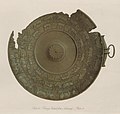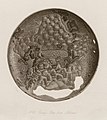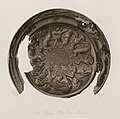Phoenician metal bowls

Phoenician metal bowls are approximately 90 decorative bowls made in the 7th–8th centuries BCE from bronze, silver and gold (often in the form of electrum), found since the mid-19th century in the Eastern Mediterranean and Iraq.[1] They were historically attributed to the Phoenicians, but are today considered to have been made by a broader group of Levantine peoples.[2][3][4][5]
The first bowls published widely had been discovered by Austen Henry Layard in 1849 in the palace of Ashurnasirpal II at Nimrud.[1] The discovery of these bowls began not just the known corpus of Phoenician metal bowls, but according to Nicholas Vella: "effectively gave birth to Phoenician art as a style, a definition with which historians of art still largely concur."[1][6] They are foundational artefacts in the study of Phoenician art, together with the Nimrud ivories, which were discovered at the same time but identified as Phoenician a few years later.[7] However, both the bowls and the ivories pose a significant challenge as no examples of either – or any other artefacts with equivalent features – have been found in Phoenicia or other major colonies (e.g. Carthage, Malta, Sicily).[8] The whole corpus was studied in detail by Glenn Markoe in 1985.[1]
The bowls contain hunting, battle, and animal scenes with clear influence from Assyrian and Egyptian art. They are thought to have been made using repoussé and chasing, as well as embossing, metalworking techniques.[1][9]
Discovery and identification
Nimrud bowls

The first bowls of this type published widely were discovered in Nimrud in 1849 by Austen Henry Layard,[10] a number of which contained short inscriptions in the Phoenician alphabet.[11][12] Layard described them as follows, identifying them as Phoenician with reference to the Biblical stories of Hiram I, who was described as a skilled bronzeworker, and the Sidonian silver mixing bowl described in book 23 of Homer's Iliad:[1]
The embossed and engraved vessels from Nimroud afford many interesting illustrations of the progress made by the ancients in metallurgy. From the Egyptian character of the designs, and especially of the drapery of the figures, in several of the specimens, it may be inferred that some of them were not Assyrian, but had been brought from a foreign people. As in the ivories, however, the workmanship, subjects, and mode of treatment are more Assyrian than Egyptian, and seem to show that the artist either copied from Egyptian models, or was a native of a country under the influence of the arts and taste of Egypt.
The Sidonians, and other inhabitants of the Phœnician coast, were the most renowned workers in metal of the ancient world, and their intermediate position between the two great nations, by which they were alternately invaded and subdued, may have been the cause of the existence of a mixed art amongst them. In the Homeric poems they are frequently mentioned as the artificers who fashioned and embossed metal cups and bowls, and Solomon sought cunning men from Tyre to make the gold and brazen utensils for his temple and palaces.[a] It is, therefore, not impossible that the vessels discovered at Nimroud were the work of Phœnician artists,[b] brought expressly from Tyre, or carried away amongst the captives when their cities were taken by the Assyrians, who, we know from many passages in the Bible, always secured the smiths and artizans, and placed them in their own immediate dominions.
They may have been used for sacrificial purposes, at royal banquets, or when the king performed certain religious ceremonies, for in the bas-reliefs he is frequently represented on such occasions with a cup or bowl in his hand; or they may have formed part of the spoil of some Syrian nation, placed in a temple at Nineveh, as the holy utensils of the Jews, after the destruction of the sanctuary, were kept in the temple of Babylon. It is not, indeed, impossible, that some of them may have been actually brought from the cities round Jerusalem by Sennacherib himself, or from Samaria by Shalmaneser or Sargon, who, we find, inhabited the palace at Nimroud, and of whom several relics have already been discovered in the ruins.[13]
Four of the bowls with inscriptions were published in the second volume of Corpus Inscriptionum Semiticarum: CIS II 1.46 (British Museum ID: N.619), CIS II 1.47 (N.50), CIS II 1.48 (N.14), CIS II 1.49 (N.19).[1]
Cyprus bowls
At around the same time, twelve silver bowls of a similar nature were found in Cyprus.[14] Ten of the bowls were lost, and presumed to have been melted down for their metal. The two remaining were acquired by antiquities dealers, and later were – separately – given to the Louvre.[15][16]
Layard claimed a connection between the Nimrud and Cyprus bowls in his books.
Etruscan tombs

The first Phoenician bowls were uncovered in modern times were in 1836 at the Regolini-Galassi tomb in the Banditaccia Necropolis of Cerveteri, about 50 km north of Rome, and were published by Luigi Grifi in 1841.[17] However, these were not widely known at the time of Layard's 1849 discoveries in Nimrud, and the specific connection to the Phoenician bowls was only made in 1876 following the discovery of the Bernardini Tomb.[18]
In 1855 and 1876, two ancient tombs were uncovered in Palestrina (ancient Praeneste), around 30 km east of Rome – the Barberini Tomb and the Bernardini Tomb.[19][1] They contained a number of silver bowls, including one with a detailed Phoenician inscription that was published a few years later as CIS I 164.[20] Following the Bernardini tomb discovery, archaeologist Wolfgang Helbig published a letter he had written to Sardinian antiquarian and politician Giovanni Spano, who had himself published the Pauli Gerrei trilingual inscription about 15 years previously. The letter was entitled Notes on Phoenician Art, and included a detailed survey of all the Phoenician metal bowls that had been found to date.[18]
Today many of the bowls from Etruscan tombs are at the Museo Gregoriano Etrusco in the Vatican.[1]
Gallery
-
Michael C. Carlos Museum, Atlanta
-
Bowls in the Corpus Inscriptionum Semiticarum II; the bottom of the page shows the sides of inscribed Nimrud bowls
-
From the Regolini-Galassi tomb
-
From the Regolini-Galassi tomb
-
From the Regolini-Galassi tomb
-
From Nimrud (see original at the British Museum: BM 115505)
-
From Nimrud (see original at the British Museum: BM N.29)
-
From Nimrud (see original at the British Museum: BM 115503)
-
From Nimrud (see original at the British Museum: BM N.10)
-
From Nimrud
-
From Nimrud
-
From the Cesnola collection at the Metropolitan Museum of Art
-
From the Cesnola collection at the Metropolitan Museum of Art
-
From the Cesnola collection at the Metropolitan Museum of Art
-
From the Cesnola collection at the Metropolitan Museum of Art
-
Display at the Metropolitan Museum of Art
Notes
- ^ Layard's footnote: "1 Kings, vii. 13, 14. 2 Chron. iv. The importance attached to such objects in metal, which were chiefly used for sacred purposes, is shown by its being especially recorded that Huram (or Hiram), the widow's son, was sent for to make "the pots, and the shovels, and the basons.” Homer particularly mentions Sidonian goblets as used at the funeral games of Patroclus."
- ^ Layard's footnote: "It will be remembered that Phœnician characters occur on one of the plates. The discovery in Cyprus of twelve silver bowls very closely resembling those found at Nimroud, tend further to confirm the idea that many of these relics were the works of Phœnician artists; unfortunately only two of these curious vessels have been preserved; they are now in Paris; one, the most perfect, in the collection of the Duc de Luines, the other placed by M. de Saulcy in the Louvre."
References
- ^ a b c d e f g h i Vella, Nicholas (2010). ""Phoenician" metal bowls : boundary objects in the Archaic period" (PDF). Bollettino di Archeologia on Line. I: 22–37. ISSN 2039-0076.
- ^ Martin, S. Rebecca (2017). The Art of Contact: Comparative Approaches to Greek and Phoenician Art. University of Pennsylvania Press, Incorporated. ISBN 978-0-8122-9394-4.
The first three discoveries of what would be known as Phoenician art occurred in the 1830s and 1840s at Etruscan Cerveteri, Assyrian Nimrud, and Cyprus. Each findspot produced decorated metal bowls…. The bowls were soon tied to the Levant, in part because their physical properties and wide distribution recalled Homer's Phoenicians. One bowl was inscribed in Phoenician, confirming the association; other bowls soon followed. While according to biblical sources (e.g., 2 Chr 2:13–14) areas of Phoenicia, such as Tyre, were producing luxury arts already in the tenth century, these bowls do not seem to date before the eighth century. A variety of regional labels has been applied to the more than one hundred examples, many fragmentary, of the metal bowls that are now known.
- ^ Onnis, Francesca (2013). "The Influence of the Physical Medium on the Decoration of a Work of Art: A Case Study of the "Phoenician" Bowls". Critical Approaches to Ancient Near Eastern Art. EBL ebooks online. De Gruyter. pp. 159–180. doi:10.1515/9781614510352.159. ISBN 978-1-61451-035-2. Retrieved 2021-12-13.
- ^ Sciacca, Ferdinando (2006). "La circolazione dei doni nell'aristocrazia tirrenica: esempli dall'archeologia" (PDF). Revista d'arqueologia de Ponent; Núm.: 16-17 (in Italian). 16–17: 281–292. hdl:10459.1/45270.
- ^ Neri, Diana (2000). Le coppe fenicie della tomba Bernardini nel museo di Villa Giulia. La Spezia: Agorà. ISBN 88-87218-18-8. OCLC 49386481.
- ^ Martin, S. Rebecca (2017). The Art of Contact: Comparative Approaches to Greek and Phoenician Art. University of Pennsylvania Press, Incorporated. p. 88. ISBN 978-0-8122-9394-4.
Even though objects are on record as early as the 1624 discovery of a terracotta anthropoid sarcophagus on Malta, sustained academic and museological interest in Phoenician art history began only in the mid-nineteenth century… The idea of a Phoenician artistic style first emerged through study of discoveries of metal bowls by Layard and others.
- ^ Richard David Barnett. “The Nimrud Ivories and the Art of the Phoenicians” Iraq, vol. 2, no. 2, British Institute for the Study of Iraq, 1935, pp. 179–210, https://doi.org/10.2307/4241579. “The Nationality of the NW. Palace Ivories: That the group of ivories was not Assyrian was concluded on their discovery from their Egyptian appearance. Francois Lenormant, in the Bulletin archéologique de l'Athenaeum français, No. 6, June 1856, asserted that his father, Charles, had been the first to recognize that the pseudo-Egyptian workmanship was in reality Phoenician, whereas Dr. Birch of the British Museum, the ivories' first publisher, had held them for Egyptian work executed in Assyria, or copied there. Posterity, a few dissentients apart, has followed Lenormant, and some wilder misattributions might have been avoided had it been noticed, as stated above, that in Layard's group seven pieces bore a letter of the Phoenician alphabet, and in that of Loftus were two inscriptions apparently also Phoenician. (There seem to be weaker reasons for describing them as Aramaic.) Modern work has only enhanced the plausibility of Lenormant's view. Other ivories of similar type have been found at Samaria, the capital of Ahab, whose connexions with Tyre were notorious. Again, those found at Arslan Tash in North Syria, according to a fragment among them which bore an inscription in what is either Phoenician or Aramaic, were seemingly made and presented by some Phoenician tributaries of Damascus to their overlord. To these points we may add the internal evidence of the religious scenes themselves, which in Part II of this paper are shown to be just such as would be expected in the art of a country so situated as Phoenicia. A concluding point of internal detail, in striking confirmation, is that the loggia windows represented on the panels of the 'Woman at the Window' illustrate what is in the Talmud called 'the Tyrian window', 'through which one can put one's head', i.e. παρακπύτειν, in contrast to the Egyptian type, through which one could not.”
- ^ Martin, S. Rebecca (2017). The Art of Contact: Comparative Approaches to Greek and Phoenician Art. University of Pennsylvania Press, Incorporated. pp. 28, 89. ISBN 978-0-8122-9394-4.
The two greatest challenges of Phoenician art history are thus highlighted by these critical early discoveries: none of the metal bowls and hardly any ivories were found in Phoenicia, and the portable objects that we assign to Phoenician manufacture do not necessarily share stylistic or iconographic features with one another or with material excavated in Phoenicia. Yet it is almost universally believed that these two genres, metal bowls and carved ivories, mark the inception of Phoenician fine art… While it is tempting to ascribe to lack of excavation the problem of discovering the "true" Phoenician origins of worked ivory and metal bowls, the idea is probably fantastical. We have very little direct evidence of metal working or ivory working on the mainland. Published areas of the well-excavated Sarepta (Sarafand, Lebanon) yielded fewer than ten ivory objects, only three of which are figurative, and not even one scrap of a "Phoenician" metal bowl. And, as Hans Niemeyer and others point out, neither bowls nor ivories appear in the main colonies, not at Carthage, Malta, Sicily, or elsewhere. Even Markoe, the foremost expert on "Phoenician" metal bowls, admitted regarding those from Assyria, "we simply do not know where these vessels were produced."
- ^ Martin, S. Rebecca (2017). The Art of Contact: Comparative Approaches to Greek and Phoenician Art. University of Pennsylvania Press, Incorporated. ISBN 978-0-8122-9394-4.
- ^ Onnis, Francesca (2009). "The Nimrud bowls: new data from an analysis of the objects". Iraq. 71: 139–150. doi:10.1017/S0021088900000796. ISSN 0021-0889. JSTOR 20779008. S2CID 193302477.
- ^ Yadin, Yigal (1967). "A note on the Nimrud bronze bowls". Eretz-Israel: Archaeological, Historical and Geographical Studies. H: 6*–7*. ISSN 0071-108X. JSTOR 23616860.
- ^ Barnett, Richard David (1967). "Layard's Nimrud bronzes and their inscriptions". Eretz-Israel: Archaeological, Historical and Geographical Studies. H: 1*–6*. ISSN 0071-108X. JSTOR 23616859.
- ^ Layard, A.H. (1853). Discoveries in the Ruins of Nineveh and Babylon: With Travels in Armenia, Kurdistan and the Desert: Being the Result of a Second Expedition Undertaken for the Trustees of the British Museum. Discoveries in the Ruins of Nineveh and Babylon: With Travels in Armenia, Kurdistan and the Desert: Being the Result of a Second Expedition Undertaken for the Trustees of the British Museum. J. Murray. pp. 192–193. Retrieved 2021-12-13. Paragraph breaks added for legibility.
- ^ Karageorghis, Vassos (1999). "A Cypriot Silver Bowl Reconsidered 1. The Iconography of the Decoration". Metropolitan Museum Journal. 34: 13–20. doi:10.2307/1513042. ISSN 0077-8958. JSTOR 1513042. S2CID 191381288.
- ^ Merrillees, Robert Stuart (2016). "Studies on the provenances of the stele of Sargon II from Larnaca (Kition) and the two so-called Dhali (Idalion) silver bowls in the Louvre". Cahiers du Centre d'Études Chypriotes (in French). 46 (1): 349–386. doi:10.3406/cchyp.2016.1698. ISSN 0761-8271.
- ^ Adrien Prévost de Longpérier, 1853, Coupes d’argent assyriennes au musée du Louvre, L’Athenaeum français. Journal universel de la littérature, de la science et des beaux-arts, No. 10, 7 Mai, p. 443-444.
- ^ Grifi, Luigi (1841). Monumenti di Cere antica spiegati colle osservanze del culto di Mitra (in Italian). Presso Alessandro Monaldi. Retrieved 2021-12-21.
- ^ a b Wolfgang Helbig, 1876. Cenni sopra l’arte fenicia, (Lettera di W. Helbig al sig. senatore G. Spano) [English title: Notes on Phoenician Art], Annali dell’Instituto di Corrispondenza Archeologica, 48, 197–257. From page 211: "...Ma lo credo superfluo, perche lo stesso ripostiglio di Palestrina contiene un monumento che esclude qualunque dubbio. La tazza d'argento cioè raffigurata sulla nostra tav. XXXII p. 1 è insignita con un' iscrizione fenicia che probabilmente riferisce il nome del fabbricante... Debbo ancor aggiungere, che già altri dotti' sopra il carattere dell'arte fenicia hanno esternato un'opinione somigliante a quella da me esposta ; ma cotale opinione sinora non era stata sviluppata sistematicamento e nemmeno si era applicata ai suddetti vasi d'argento.... Il risultato ora assicurato, che i Fenicii lavoravano in uno stile che ora imita l'egiziano, ora l'assiro, e più volte mischia ambedue le direzioni artistiche, riesce proficuo sotto molti punti di vista."
- ^ Curtis, C. Densmore. “The Barberini Tomb.” Memoirs of the American Academy in Rome, vol. 5, [American Academy in Rome, University of Michigan Press], 1925, pp. 9–52, https://doi.org/10.2307/4238524.
- ^ Curtis, C. Densmore (1919). "The Bernardini Tomb". Memoirs of the American Academy in Rome. 3: 9–90. doi:10.2307/4238513. ISSN 0065-6801. JSTOR 4238513.
Further reading
- Markoe, G.; University of California, Berkeley (1985). Phoenician Bronze and Silver Bowls from Cyprus and the Mediterranean. Publications in classical studies. University of California Press. ISBN 978-0-520-09663-9.
- Imai, A. (1977). Some Aspects of "Phoenician Bowls" with Special Reference to the Proto-Cypriote Class and the Cypro-Phoenician Class. Some Aspects of "Phoenician Bowls" with Special Reference to the Proto-Cypriote Class and the Cypro-Phoenician Class. Columbia University.
- Falsone, Gioacchino (1985). "A Syro-Phoenician Bull-Bowl in Geneva and its Analogue in the British Museum". Anatolian Studies. 35: 131–142. doi:10.2307/3642879. ISSN 2048-0849. JSTOR 3642879. (regarding a bowl at the Fondation Hardt pour l’Étude de l’Antiquité Classique)
- Histoire de l'art dans l'antiquité: Égypte, Assyrie, Perse, Asie Mineure, Grece, Etrurie, Rome, Perrot, Georges; Chipiez, Charles
- Der Orient und die frühgriechische Kunst, Poulsen, Frederik























